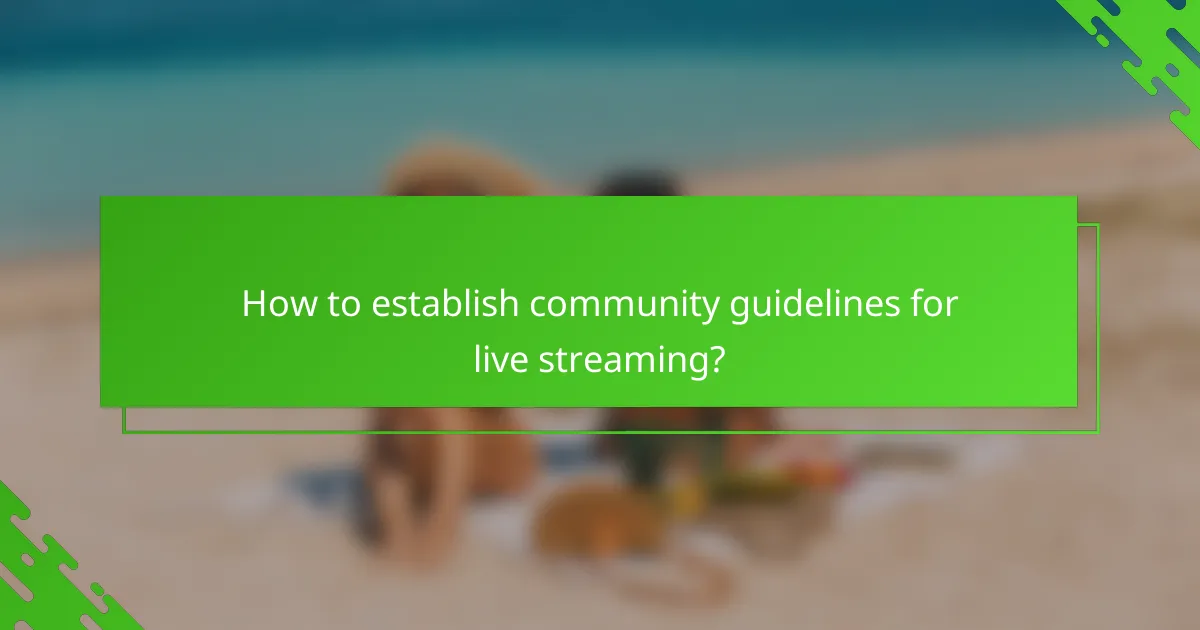Moderating live streaming is crucial for fostering a positive and engaging environment for viewers. By effectively managing comments, utilizing moderation tools, and establishing clear community guidelines, streamers can enhance user interaction and satisfaction. Implementing these strategies not only helps maintain order but also cultivates a vibrant and welcoming community for all participants.

How to manage comments in live streaming?
Managing comments in live streaming is essential for maintaining a positive environment and ensuring user engagement. Effective comment management involves utilizing moderation tools, implementing filters, and assigning moderators to oversee interactions in real time.
Utilize moderation tools like Streamlabs
Moderation tools such as Streamlabs provide features that help manage comments efficiently during live streams. These tools allow streamers to set up automated responses, filter out spam, and highlight important messages from viewers. By integrating these tools, streamers can focus more on content delivery while ensuring a smooth chat experience.
Streamlabs also offers customizable settings that enable streamers to tailor the moderation experience to their community’s needs. For instance, you can adjust the level of moderation based on the size of your audience, from strict filtering for larger streams to more relaxed settings for smaller, intimate gatherings.
Implement keyword filters for inappropriate content
Keyword filters are a practical way to block inappropriate content in live streaming comments. By setting up a list of banned words or phrases, streamers can prevent harmful or offensive messages from appearing in the chat. This proactive approach helps maintain a respectful atmosphere and encourages positive interactions among viewers.
It’s advisable to regularly update your keyword list based on community feedback and emerging trends. Additionally, consider using variations of words to cover different spellings or slang, ensuring comprehensive coverage against unwanted comments.
Assign moderators for real-time oversight
Assigning moderators is crucial for effective comment management during live streams. Moderators can monitor the chat in real time, responding to issues as they arise and enforcing community guidelines. This immediate oversight helps prevent toxic behavior and keeps the conversation on track.
When selecting moderators, choose individuals who are familiar with your community and its standards. It’s beneficial to have a diverse team of moderators to cover different time zones and ensure consistent oversight across all streams. Providing clear guidelines on their responsibilities will empower them to act confidently and effectively.

What are effective user engagement strategies?
Effective user engagement strategies in live streaming involve creating interactive experiences that keep viewers involved and invested. These strategies can enhance viewer satisfaction and retention, ultimately leading to a more vibrant community.
Incorporate interactive polls and Q&A sessions
Interactive polls and Q&A sessions allow viewers to participate actively in the stream. By asking questions related to the content or allowing viewers to submit their queries, streamers can create a dynamic environment that encourages interaction.
Consider using tools that enable real-time responses, such as integrated polling features or dedicated Q&A platforms. This not only boosts engagement but also provides valuable feedback on viewer preferences and interests.
Use chatbots for instant responses
Chatbots can significantly enhance user engagement by providing instant responses to common questions. They can handle inquiries about stream schedules, content topics, or community guidelines, allowing moderators to focus on more complex interactions.
Implementing a chatbot can streamline communication, especially during peak viewing times. Ensure the bot is programmed with relevant information and can escalate issues to human moderators when necessary.
Encourage viewer participation through shoutouts
Shoutouts are an effective way to recognize and appreciate viewer contributions, fostering a sense of community. Acknowledging viewers by name during the stream can motivate others to engage more actively.
Consider setting specific milestones for shoutouts, such as reaching a certain number of likes or comments. This creates incentives for viewers to participate and can lead to increased interaction and loyalty within the community.

How to establish community guidelines for live streaming?
Establishing community guidelines for live streaming involves creating clear rules that promote a positive environment for all participants. These guidelines should be easily accessible and outline expected behaviors, consequences for violations, and a process for updates based on community input.
Define acceptable behavior clearly
Clearly defining acceptable behavior is crucial for maintaining a respectful and engaging live streaming environment. Guidelines should specify what constitutes positive interaction, such as encouraging constructive feedback, respecting diverse opinions, and avoiding hate speech or harassment.
Consider using examples to illustrate acceptable behavior, such as praising creativity or providing helpful suggestions. This clarity helps users understand the community’s values and expectations.
Outline consequences for guideline violations
Outlining consequences for violations of community guidelines ensures accountability and discourages negative behavior. Clearly state the potential repercussions, which may include warnings, temporary bans, or permanent removal from the community.
It’s beneficial to establish a tiered system of consequences, where minor infractions result in lighter penalties, while serious offenses lead to more severe actions. This approach allows for fair treatment and encourages users to adhere to the guidelines.
Regularly update guidelines based on community feedback
Regularly updating community guidelines based on user feedback fosters a sense of ownership and relevance within the community. Encourage users to share their thoughts on the guidelines, which can help identify areas for improvement or clarification.
Consider conducting periodic reviews of the guidelines, perhaps every few months, to ensure they remain aligned with community values and address any emerging issues. This practice not only enhances user engagement but also demonstrates that the community is responsive to its members’ needs.

What tools can enhance live streaming moderation?
Effective live streaming moderation relies on various tools that help manage comments, engage users, and enforce community guidelines. Utilizing the right platforms can streamline moderation tasks and foster a positive environment for viewers.
Explore platforms like Twitch Moderation Tools
Twitch offers a suite of moderation tools designed to help streamers manage their chat effectively. Features include auto-moderation settings, customizable chat filters, and the ability to assign moderators who can manage comments in real-time. Streamers can also utilize the “Slow Mode” feature to limit the frequency of messages from users, reducing spam.
Consider using bots like Nightbot or Moobot, which can automate responses and filter out inappropriate content. These bots can be programmed to recognize specific keywords or phrases, allowing for a more hands-off approach to moderation.
Use Discord for community management
Discord serves as an excellent platform for managing community interactions outside of live streams. By creating dedicated channels for discussions, streamers can guide conversations and keep the chat organized. Discord also allows for voice and video interactions, enhancing user engagement.
Utilizing Discord bots can further enhance moderation capabilities. Bots can manage user roles, enforce rules, and even provide automated responses to frequently asked questions. Setting clear community guidelines within Discord helps maintain a respectful atmosphere.
Leverage YouTube’s built-in moderation features
YouTube provides several built-in moderation features that assist streamers in managing live chat. Streamers can enable “Hold potentially inappropriate comments for review,” which allows them to filter out unwanted messages before they appear. Additionally, the ability to designate moderators grants trusted users the power to manage chat effectively.
Streamers can also use the “Live Chat Replay” feature to review comments after the stream, helping to identify any issues that may need addressing in future broadcasts. Regularly updating community guidelines based on viewer feedback can help improve the overall experience.

What are the best practices for engaging with viewers?
Engaging with viewers effectively enhances their experience and encourages loyalty. Key practices include timely responses to comments, personalized interactions, and hosting regular live events to keep the audience interested.
Respond to comments promptly
Timely responses to viewer comments can significantly boost engagement. Aim to reply within a few minutes to foster a sense of community and show that you value their input.
Consider setting aside specific times during your stream to address comments. This can help manage the flow of conversation and ensure that viewers feel heard.
Personalize interactions to build rapport
Personalizing your interactions can create a stronger connection with your audience. Use viewers’ names and reference their comments directly to make them feel recognized.
Incorporate viewer feedback into your content when possible. This not only shows that you listen but also encourages more viewers to participate, knowing their opinions matter.
Host regular live events to maintain interest
Regular live events keep your audience engaged and coming back for more. Schedule these events consistently, whether weekly or monthly, to establish a routine that viewers can anticipate.
Consider varying the format of your live events, such as Q&A sessions, tutorials, or guest appearances, to keep the content fresh and exciting. This variety can attract different segments of your audience and maintain overall interest.

How to analyze user engagement metrics?
Analyzing user engagement metrics involves tracking various indicators that reflect how viewers interact with your live stream. Key metrics include viewer retention, chat activity, and feedback, which together provide insights into audience behavior and preferences.
Track viewer retention rates using analytics tools
Viewer retention rates indicate how long your audience stays engaged during a live stream. Use analytics tools such as YouTube Analytics or Twitch Insights to monitor this metric, focusing on average watch time and drop-off points. Aim for retention rates above 50% to ensure your content remains captivating.
Consider segmenting your stream into different parts to identify which segments hold viewers’ attention. For example, if a tutorial segment sees a significant drop-off, it may need to be restructured or made more engaging.
Measure chat activity and participation levels
Chat activity and participation levels are crucial indicators of user engagement during live streams. Track metrics like the number of messages sent, unique participants, and peak chat rates to gauge audience involvement. A lively chat can indicate high engagement, while low activity may suggest viewers are not fully invested.
Encourage participation by asking questions or prompting viewers to share their thoughts. For instance, consider running a Q&A session or polls during the stream to stimulate conversation and keep the chat active.
Evaluate feedback through surveys and polls
Surveys and polls are effective tools for gathering direct feedback from your audience about their viewing experience. Use platforms like Google Forms or integrated polling features on streaming services to create quick surveys that assess viewer satisfaction and preferences.
Distributing surveys immediately after the stream can yield valuable insights. Aim for concise questions that cover aspects such as content quality, pacing, and overall enjoyment. This feedback can guide future content decisions and enhance viewer engagement.
